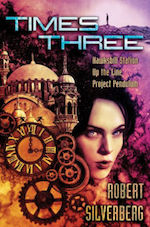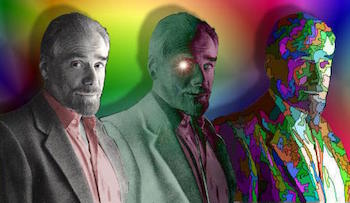Robert Silverberg, one of science fiction’s Grand Masters, is a fascinating guy to chat with. I recommend it, if you get the chance at the next WorldCon—and he’s attended sixty-two in a row, so, barring the unforeseen, the odds are good that he’ll be at Helsinki in 2017. He also does other events once in a while.
But let’s suppose that talking to him isn’t feasible, or not your style. The next best way to see his brilliant mind in action is by reading his work—here are seven reasons why it remains essential today.
1. Inspiration and Influence
 As Jo Walton wrote recently, “There’s a tremendous continuity within science fiction, where the genre constantly feeds on itself, reinvents itself, and revisits old issues in new ways as times and tech change.”
As Jo Walton wrote recently, “There’s a tremendous continuity within science fiction, where the genre constantly feeds on itself, reinvents itself, and revisits old issues in new ways as times and tech change.”
This certainly applies to Silverberg’s work, which has inspired a cadre of fantastic writers, like Nancy Kress, Mike Resnick, Elizabeth Bear, James Patrick Kelly, Caitlín R. Kiernan and even Connie Willis. You can find explicit tribute stories to him by these authors in The Book of Silverberg (2014). In other cases the responses to his fiction are less obvious: Ian McDonald’s novel Necroville (1994), for example, is a take on Silverberg’s award-winning novella “Born with the Dead.” Incidentally, this same story also inspired Damien Broderick’s excellent “Quicken,” an authorized sequel published in 2013.
Not only is Silverberg’s influence as a storyteller evident, but he’s published dozens of substantial anthologies. If you want to delve into the behind-the-scenes-mechanics of short stories, Science Fiction: 101: Exploring the Craft of Science Fiction (2014) is a must. Other anthologies edited by Silverberg featured the first publication of unforgettable stories. The New Dimensions series (1971-1981; 12 volumes), in particular, gave us Gardner Dozois’ “A Special Kind of Morning” and “Strangers,” Joanna Russ’ “Nobody’s Home,” Ursula K. Le Guin’s “Vaster Than Empires and More Slow” and “The Ones Who Walk Away from Omelas,” James Tiptree, Jr.’s “The Girl Who Was Plugged In” and “The Psychologist Who Wouldn’t Do Awful Things to Rats,” and many, many others.
2. He Keeps Popping Up as a Character in Other People’s Work!
 Speaking of Jo Walton, have you read her Hugo-winning Among Others (2011)? You should; it’s a marvelous, touching novel, and one warmly in dialog with science fiction’s past. Silverberg gets eight or nine mentions. My favorite one:
Speaking of Jo Walton, have you read her Hugo-winning Among Others (2011)? You should; it’s a marvelous, touching novel, and one warmly in dialog with science fiction’s past. Silverberg gets eight or nine mentions. My favorite one:
“Robert Silverberg was there. I talked to him! And Vonda McIntyre!”
I could hardly believe I was sitting in the same room as someone who had talked to Robert Silverberg.
Silverberg makes another appearance in Allen Steele’s Arkwright (2016). Here he has an almost-speaking part, in a plausible but invented panel on “The Future of the Future,” also featuring Fred Pohl, Stanley Schmidt, and the fictional Nat Arkwright:
Bob Silverberg leaned forward to speak, but Nat cut him off before he could utter a word.
And just last month, reading Jeffrey Ford’s mind-bogglingly good collection of short stories, A Natural History of Hell (2016), there was Silverberg again! From “Rocket Ship to Hell”:
“Eighteen stories in four years? That’s pretty impressive,” I said.
“Not really, not for the time. Some of those writers back then cranked ’em out a couple a month. I think Silverberg published a hundred by the time he was this young lady’s age. I was twenty when I published the first one.”
3. A Short Story for Every Occasion
 Speaking of prolificity, the character in Jeffrey Ford’s story isn’t exaggerating. In his early days Silverberg wrote a gob-smacking number of pulpy stories for every imaginable (paying) market, not only science fiction and monster stories but crime, mysteries, sports, Western yarns, and so on. In 1956, for example, he published 62 stories; in 1957 he published 101 stories (!); and then 84 more in 1958.
Speaking of prolificity, the character in Jeffrey Ford’s story isn’t exaggerating. In his early days Silverberg wrote a gob-smacking number of pulpy stories for every imaginable (paying) market, not only science fiction and monster stories but crime, mysteries, sports, Western yarns, and so on. In 1956, for example, he published 62 stories; in 1957 he published 101 stories (!); and then 84 more in 1958.
His more experimental stories from the late 60s and 70s, an imaginatively fecund period in which he more consciously focused on form and technique, use all sorts of styles and narrative devices. First person, second person, third person, past tense, present tense, future tense, combinations of all the above (“Sundance,” for example), epistolary stories, stories in the guise of lists, relics, verse fragments, constantly shifting perspectives or even science fiction as the subject itself (“The Science Fiction Hall of Fame”). Volumes 3 and 4 of the 9-volume Collected Stories issued by Subterranean Press cover this phase, and will delight connoisseurs of the short story, as well as writers looking for a useful showcase of multiple storytelling approaches.
If that sounds a little too rich, The Best of Robert Silverberg: Stories of Six Decades (2012) is an excellent career retrospective.
4. Time Travel
 This is one of the perennial tropes of science fiction, and Silverberg has run just about every conceivable variation on it. It’s fair to say he’s obsessed with it.
This is one of the perennial tropes of science fiction, and Silverberg has run just about every conceivable variation on it. It’s fair to say he’s obsessed with it.
The omnibus Times Three (2011) collects Hawksbill Station (1968), a fascinating story of criminals exiled to the ancient past, Up the Line (1969), a ribald, Byzantine tale of time-tourism crammed full of paradoxes, and Project Pendulum (1987), a far-future story of twin time travelers. In the YA novel Letters From Atlantis (1990) the protagonist’s disembodied consciousness travels back eighteen-thousand years into the mind of the Prince of Atlantis. If you want to travel to Ancient Egypt, Thebes of the Hundred Gates (1992) will show you its splendors. Then there’s also The Time Hoppers (1967), The Masks of Time (1968), Son of Man (1971), and, based on the Asimov story, The Ugly Little Boy (1991).
Besides these novels, he’s cooked up dozens of snack-sized chrono-journeys, with irresistible titles like “Needle in a Timestack,” “Against the Current,” “{Now + n, Now – n},” “When We Went to See the End of the World,” “Sailing to Byzantium,” and “In Another Country.”
5. World-Building
 Okay, so maybe you’re not in the mood for a decadent dystopia of massive overpopulation in a claustrophobic world of gigantic high-rises (The World Inside, 1971], or a death-invoking, four-POV college road trip in search of immortality (The Book of Skulls, 1971), or the gloomy ruminations of an outsider from a society where the very word “I” is banned (A Time of Changes, 1971), or even an angsty exploration of the inner struggles of an urban telepath losing his abilities (Dying Inside, 1972).
Okay, so maybe you’re not in the mood for a decadent dystopia of massive overpopulation in a claustrophobic world of gigantic high-rises (The World Inside, 1971], or a death-invoking, four-POV college road trip in search of immortality (The Book of Skulls, 1971), or the gloomy ruminations of an outsider from a society where the very word “I” is banned (A Time of Changes, 1971), or even an angsty exploration of the inner struggles of an urban telepath losing his abilities (Dying Inside, 1972).
Maybe what you want is entertaining adventure in an epic world.
Enter Lord Valentine’s Castle (1980).
Unlike most door-stoppers that feature maps in their opening pages, the planet Majipoor—the real character in this popular series of novels and stories—is not a fantasy creation, but a science-fictional one. Vast, metal-poor (hence low tech), low-density (hence normal Earth gravity), this alien world is host to fascinating alien species, like the native shape-shifting Piurivar or the mysterious two-headed Su-Suheris. The geographical and historical scope are immense, and the color and texture rendered with astonishing detail; Majipoor feels incredibly real.
Case in point: the editor of a critically-acclaimed magazine recently shared with me that “Lord Valentine’s Castle was my Harry Potter!” And then she added: “I recently re-read that book and realized the opening chapter and its prose really shaped me as a writer, without me knowing until now.” (Which takes us back to 1.)
And if you find yourself getting your groove on with Majipoor, you may want to try the lesser-known, two-volume New Springtime series, rife with more thoughtful world-building and a clutch of memorable post-human species.
6. Get In Early
 Many of Silverberg’s stories and novels have been, or are currently, under Hollywood option. When I talked to him last year about this subject, for our book of conversations, he mentioned that there were eight pieces under option at the time: The Book of Skulls, Dying Inside, “How It Was When the Past Went Away,” “Passengers,” Downward to the Earth, The World Inside, “Needle in a Timestack” and Hawksbill Station. It’s hard to believe that at some point one of his books or stories won’t be turned into a movie or mini-series. Stay ahead of the game!
Many of Silverberg’s stories and novels have been, or are currently, under Hollywood option. When I talked to him last year about this subject, for our book of conversations, he mentioned that there were eight pieces under option at the time: The Book of Skulls, Dying Inside, “How It Was When the Past Went Away,” “Passengers,” Downward to the Earth, The World Inside, “Needle in a Timestack” and Hawksbill Station. It’s hard to believe that at some point one of his books or stories won’t be turned into a movie or mini-series. Stay ahead of the game!
7. The History of Our Field
 Silverberg has written over fifty nonfiction books, primarily on history and archaeology. Notable titles in print today include The Mound Builders, The Realm of Prester John, The Longest Voyage, Ghost Towns of the American West, The Golden Dream, and Scientists and Scoundrels. He’s also been a significant chronicler of and commentator on our genre, particularly in his ongoing column at Asimov’s. Many of his best essays are gathered in Reflections and Refractions (1997; expanded edition 2016) and Musings and Meditations (2011). For an autobiographical focus, check out Others Spaces, Other Times (2009).
Silverberg has written over fifty nonfiction books, primarily on history and archaeology. Notable titles in print today include The Mound Builders, The Realm of Prester John, The Longest Voyage, Ghost Towns of the American West, The Golden Dream, and Scientists and Scoundrels. He’s also been a significant chronicler of and commentator on our genre, particularly in his ongoing column at Asimov’s. Many of his best essays are gathered in Reflections and Refractions (1997; expanded edition 2016) and Musings and Meditations (2011). For an autobiographical focus, check out Others Spaces, Other Times (2009).
And if you want something a little more casual and conversational—like eavesdropping on one of those chats I mentioned at the start of this piece—I’ll shamelessly say that Traveler of Worlds: Conversations with Robert Silverberg (2016) by Yours Truly should do the trick.
Bonus Reason: You Need an Awards Presenter, Length of Presentation Undetermined…
You’re hosting an important science fiction awards ceremony, and you need a presenter who can stall with sardonic quips and droll digressions: Bob Silverberg is your man!
 Alvaro Zinos-Amaro writes fiction, of the non-tingler variety, and non-fiction, of the technicolor kind.
Alvaro Zinos-Amaro writes fiction, of the non-tingler variety, and non-fiction, of the technicolor kind.










